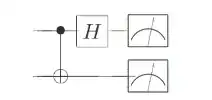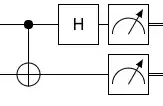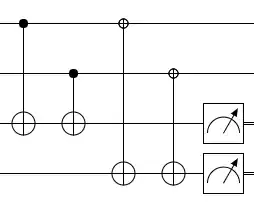Nielsen and Chuang (on page 188 exercise 4.33) says that the circuit including CNOT and Hadamard is performing a measurement in the Bell basis. But I can't see how.
The matrix representing the circuit functionality is:
$$\begin{bmatrix} 1 & 0 & 0 & 1 \\ 0 & 1 & 1 & 0 \\ 1 & 0 & 0 & -1 \\ 0 & 1 &-1 & 0 \end{bmatrix}$$
Now, what I have found out is, that instead of measuring in the Bell state, it is actually simply converting $|00\rangle$ to $\beta_{00}$, $|01\rangle$ to $\beta_{01}$ and vice versa and so on. So it's actually transforming from one basis to another. But how is it a measurement in the Bell state?
Suppose you take the vector $(1,0,0,0)$ in the Bell state it's written $(1,0,1,0)$ then when measuring in Bell state I would expect you get either $(1,0,0,0)$ which is $|00\rangle + |11\rangle$ or $(0,0,1,0)$ which is $|00\rangle-|11\rangle$. But why isn't it doing the measurement but just converting from basis to basis and yet Wikipedia says it's a measurement?


